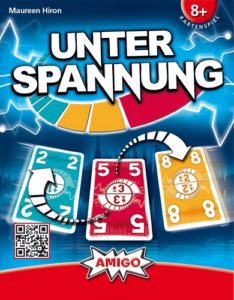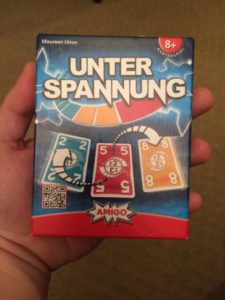Noria* is an innovative action selection rondel (or “wheel building”) game from Spiel de Jahres fellowship designer Sophia Wagner. It’s definitely a gamer’s game, with an age range suggestion of 12+.
It will take one to four players one to two hours to play, with more players adding to the time; but it’s a pretty thinky game, so slower players could well see this running longer.
The game has some beautiful sci-fi artwork from two of board game design’s heavyweights, Klemens Franz and Michael Menzel. But don’t expect any actual theme in the game: in reality this is very much an abstract euro game. For example, while the boards and cardboard pieces look amazing there is no flavour text or names on anything outside of the rulebook.
In the box you’ll find a central playing board, 4 player action wheels, 44 wooden pieces and around 300 cardboard chits. You’ll pay around £50 fora copy, which is about average for a big box game in the current climate - which seems reasonable for what you’ll get here.
Teaching
Unfortunately I have to start by saying that this is one of the worst rulebooks I’ve had to plough through in a long time. It took me three or four attempts to wade through it; but once I had, I found a game that’s actually relatively simple to teach. How they got the rulebook so badly wrong is a mystery to me.
Much of the experience is very much a nuts and bolts resource management/economic game. You take actions via your rondel (see below) to journey to locations and buy ships or factories; gather resources needed to make these goods (the more ships you have, the more you will be able to collect); or invest the goods/resources you’ve collected to turn them into victory points on one of four victory point tracks.
Then, at the end of your turn, you can influence the value of a victory point track by increasing - or limiting the increase potential - of these same victory point tracks. At the end of the game, each track’s value will simply be a multiplication of how many good you’ve delivered to it multiplied by the level of influence it has been raised to. So far, so every economic game ever.
How you efficiently get the cubes (sorry, resources) you need - the engine building - is the interesting bit. Each player has their own three-tiered rondel. The top tier has two spaces for actions, the middle four and the bottom six. You start the game with five of the spaces filled (one top, two middle, two bottom) and each round you will turn each level one space clockwise. On each turn, only half (six) of these actions are available to you and you can only use three of them (one from each level).
This is where you build your engine. Three of the rondel actions allow you to variously gain extra action discs to add to your rondel; make an action doubly efficient (by flipping a disc over); or gain bonus actions.
And don’t worry - there’s also a mechanism in place to move your discs around later when you realise you’ve screwed up. It’s a neat system: actions on the two-space top tier will be available one round, not the next, and so on - while those on the outer tier will be available three turns on a row - but then unavailable for the next three.
This continues for 14-16 rounds (depending on the player count), after which you count up player points on the six scoring areas to decide the winner. Alongside the four score tracks associated with resources are one which scores bonus points for specialising (extra points for your highest track) of diversifying (bonus points for your lowest track). And that’s that.
Solo play
If you like a thinky puzzle, and like the sound of the game, Norias’ solo game is well worth a look. The rules weren’t in the original release but the few extra components you need are, and the official rules are on a simple two-page download. It’s quite a fiddly setup and a very hard way to learn the game from scratch, but once you get going it does a good job of giving you a bot opponent - and better still, one that tonnes of permutations if you fiddle about with its rondel.
The four sides
These are me, plus three fictitious players drawn from observing my friends and their respective quirks and play styles.
- The writer: The key for me when really enjoying an engine building game is the process of seeing that engine work - and unfortunately I just didn’t get that from Noria. Making it is an interesting puzzle, but what it does is uninspiring: no matter what colour of goods you make, they all work in exactly the same way. Instead the game relies on working the economic engine to succeed in being a good game - making me ask the crucial design question, where is the game? For me, it should be more in the rondels than in the bog standard economic game; but it feels more like the other way around.
- The thinker: This game really takes the rondel idea, so loved by Gerdts fans, to the next level in terms of strategy. The tiers flow like planets around a sun, coming in and out of the light, making for some fascinating decisions. Bonus discs add an extra level of complexity, allowing you to take fewer but more powerful actions later. All in all it makes for a hugely enjoyable and complex economic game for those looking to challenge themselves to make the most efficient engine - while constantly battling your opponents for the upper hand in terms of how you’ll score.
- The trasher: As in any economic game, the interaction in Noria comes from manipulating the score tracks to your own ends. However, because your engine feels so slow to get going you’re largely talking about small gains over a long period rather than quick tactical swings. The real work goes on with your own engine, but at least this scoring mechanism means you can’t play multiplayer solitaire - you have to pay attention to what others are working towards (both as allies or enemies) if you hope to succeed.
- The dabbler: While I understand this is a very cleverly designed game, for me it flatters to deceive at every turn and gets too many things wrong. While the board and rondels are beautiful many of the rest of the components are bland with washed out colours, while the theme - what theme? Someone has clearly designed a world in their mind, but forgotten to bring it to life in the game itself. giving resources stupid names such as ‘mycelium’ is practically forcing players to call them ‘greens’ - while the cities, ships and warehouse products could’ve been brought to life by naming them instead, and adding a little flavour text.
Key observations
I won’t harp on about it, but Noria’s rulebook is truly horrific. What makes the crime so heinous is that in reality this is a fairly easy game to teach, with the real complexity coming out as you play. This is a much quicker teach than many euro games, but has twice the rulebook.
The rondel has also been described as overwrought, over designed and in need of streamlining. I think most of these complaints come from the fact that, no matter how you set it up, it’s doing the same quite standard functions: basic actions that don’t warrant quite so much thought. Everyone loves a tricky decision, but the payoff needs to be more than it is here: no matter where I place my choices of production action discs, they’re only ever going to be letting me take one or two resources. For some it just doesn’t seem worth the bother.
But the most repeated negative comments I’ve seen centre on the stock market mechanic. Some simply write it off as uninteresting or generic, while others point to more serious issues around gameplay. With three or four players, if the majority of players go for a resource you don’t and block you out you can be on a hiding to nothing (king-making, two vs one scenarios etc). This is standard economic game tactics - but when you’re building a complex rondel engine to get those resources over several hours of gameplay, it is a much more serious problem in terms of pay off.
Conclusion
Noria was comfortably one of my most anticipated games going into Essen 2017, but of the eight of my top 10 I’ve now tried it is the most disappointing. It has gone straight onto my trade pile and while I wouldn’t turn down a game somewhere if people were very keen, I certainly won’t be seeking to play it again. I got the very same market scoring kick from Ilos - a much shorter and tactically satisfying game - while I have better engine-building and/or rondel goodness on my shelves already.
But Noria has certainly found an audience (currently a very respectable 6.8 rating on Board Game Geek) and there is undoubted merit in the rondel system - even if I don’t think it has found the right game here. If you like to build an engine (and in a unique way), convert things into other things, and have a solid level of interaction through a market mechanic, you should definitely give this game a chance - you may well find yourself a new favourite.
* I would like to thank Pegasus Spiele for providing a copy of the game for review.

 This guest review was written by
This guest review was written by 
